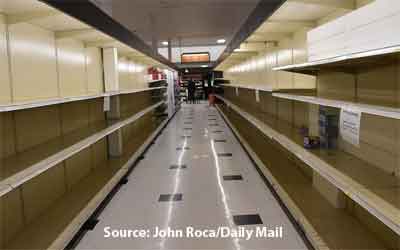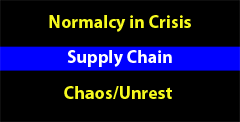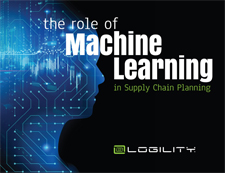The Thin Supply Chain Line Continued
Last week, I wrote a column titled "The Thin supply Chain Line," which started by noting the concept of "the thin blue line," a term meant to describe the critical but vulnerable role of the police in maintaining order and holding back chaos.
I argued that right now we are seeing a thin supply chain line serving a similar role, for now mostly managing to keep grocery store shelves filled with food and other products – with the exception of course of toilet paper.
Below is an image of the paper products aisle at a grocery store in Bridgetown, NY, with not a single item left. That scene is being repeated all over the country for paper goods, but for the most part the other groceries are there.
| GILMORE SAYS: |
So it was goods to see news this week that many users on social media are promoting the hashtag #ThankATrucker to send messages to drivers and the public.
WHAT DO YOU SAY?
Send us your
Feedback here
|
But it is a complex process across numerous supply chain functions, from global sourcing to store replenishment, to keep that flow of goods happening – and right now the supply chain line is stretched very thin indeed, with many pressure points and risks.
So for a while in this weekly column I am going to report on the past week's news and developments in the thin supply chain line – because who can think of anything else right now?
First though, last week in our Supply Chain by the Numbers feature, we happily reported that leading grocery/drug related retailers were planning to hire 500,000 for stores and distribution centers given soaring demand for staples, 100,000 positions at Amazon alone, 50,000 at Dollar General, etc.
Sadly, this week the opposite news, as many retailers such as department and many specialty stores have been forced to close their doors for now, with announced job cuts of 1 million last I saw, but that is probably low now.

The longer this goes on, the harder it is going to be for those retailers to open back up. And when they do, many will find consumer buying behaviors are fundamentally changed, with the crisis accelerating trends that were already in place.
What retail will look like after this ends I do not know, but as my friend Jim Barnes, CEO of consulting firm enVista recently said, "Stores won't go away; they'll just look different." We'll see.
I noted last week the stress that many truck drivers were under in their indespencible supply chain role, from trouble finding food and parking spaces to being turned away at the dock if they had earlier dropped off a load in a hot zone area like New York.
A report from Reuters this week, based on interviews with a number of drivers, perhaps surprisingly found many thought the virus threat was overblown, though some feared for their lives, but keep driving – and sanitizing their cabs - because they know the country needs them.
None of the US-based drivers Reuters spoke with had been provided masks, gloves or disinfectant by their employers. As I said last week, it is almost unimaginable what would happen if the virus broke out widely across the driver universe – let's pray it doesn't happen.
So it was good to see news this week that many users on social media are promoting the hashtag #ThankATrucker to send messages to drivers and the public. Good deal.
Meanwhile, travel center chains along the Interstate 80 corridor, a vital freight route that stretches from San Francisco to Teaneck, NJ, are offering free meals and parking to truck drivers making deliveries to help the nation battle the impact of the COVID-19 virus.
At least seven franchise food companies - Firehouse Subs, Long John Silver's, McDonald's, Nathan's Famous, Ruby Tuesday, Shoney's and Sonic - are offering additional parking and drive-through accommodations, while Long John Silver's and Ruby Tuesday are offering discounted meals for truck drivers.
 Next, have you considered this supply chain risk? What if the virus hits the nation's farming communities in a big way? Next, have you considered this supply chain risk? What if the virus hits the nation's farming communities in a big way?
An article on Bloomberg.com noted that US farms are heavily dependent on low paid, often undocumented migrant workers – who frequently live and work together in close quarters. Ditto for many food processors, such as those turning tomatoes into cans of sauce.
One California grower told National Public Radio that if the coronavirus penetrates the agricultural community, "it will spread like wildfire," - especially as many/most lack insurance and thus may delay calling or seeing a doctor as they get sick. Many of the farms are in rural areas with modest hospital support at best.
It seems inevitable that will happen to some degree.
"It could have a devastating effect on the ability to produce food," Dale Moore, executive vice president of the American Farm Bureau Federation, told Bloomberg's Francis Wilkinson. A thin supply chain line indeed.
The risk is not only in the fruit and vegetable section of your grocery store. Another Bloomberg article said that "A growing number of workers who are crucial to supplying the world with meat are demanding that their companies do more to keep them safe from the coronavirus."
The article said there are reports of increased absenteeism and that some front line workers have even walked off the job. "That's raising the specter of mass protests that could threaten global meat supplies just as supply chains unravel and grocery stores struggle to keep food on their shelves."
The thin supply chain line really does stand between some normalcy in a time of crisis and chaos and unrest.
On the distribution side, planned strikes against Amazon by fulfillment center workers complaining about lack of protections from the virus at the FCs and other matter mostly fizzled. Just 15 or so employees left the job in a walkout Monday at an Amazon FC in State Island, out of several thousand employees there. And then when it was over, Amazon fired the lead organizer, saying he broke company rules by returning to the FC after had been in contact with one of the workers at the facility that got the virus.
Another scheduled walkout in Chicago turned out about as poorly.
Still, the actions might have had some effect. Amazon plans that workers will receive a no-contact temperature check on arrival at an FC, and anyone who tests over 100.4 degrees Fahrenheit will be sent home. Workers will also receive surgical masks for use while on the premises. The protections are planned to be in place by next week.
Amazon also plans to monitor on-site video feeds using software algorithms to ensure workers are appropriately distanced in the workplace, addressing previous concerns about overcrowding.
Ecommerce fulfillment provider ShipBob said it set up coronavirus safety measures at its seven fulfillment centers in early March. That includes handing out masks and gloves to staffers and requiring all visitors, including vendors and drivers, to put on personal protective gear to enter its facilities.
At the retail store level, plastic guards that offer some modest protections against the virus via customer interactions went up quickly this week at point-of-sale positions at many retailers.
And Walmart said it will begin taking temperatures of US store workers at the start of each shift and offering masks for those employees who wish to wear them.
Please also consider that a group of unions, Amazon employees and 45 New York lawmakers wrote a letter to Amazon CEO Jeff Bezos demanding the company close facilities where employees have tested positive for the virus. What if that is almost all of them?
The thin supply chain line continues to hold on, though with many risks, as I hope I have convinced you. I had enough material to write two other similar columns this week.
And what happens if there is a serious breech? All the aisles will be empty then, with chaos and likely civil unrest. TMZ in fact reported this week that high end retail stores in major cities across the US and Europe were boarding up windows to protect against potential riots.
What are you thoughts in the "thin supply chain line?" Is it the right term for the times? Let us know your thought at the Feedback button below.
|












 Next, have you considered this supply chain risk? What if the virus hits the nation's farming communities in a big way?
Next, have you considered this supply chain risk? What if the virus hits the nation's farming communities in a big way?


